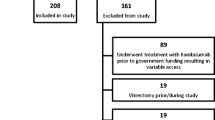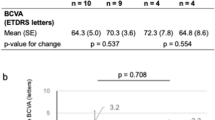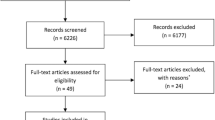Abstract
Ranibizumab, an intravitreally administered inhibitor of vascular endothelial growth factor (VEGF), is approved for the treatment of visual impairment associated with diabetic macular oedema (DME) in the EU.
In four well designed, phase II or III trials (RESOLVE, RESTORE, RIDE and RISE), 1–2 years’ treatment with ranibizumab was more effective than sham or focal/grid laser therapy in improving best corrected visual acuity (BCVA) and reducing central retinal thickness (CRT) in patients with visual impairment associated with DME.
Additionally, in two well designed phase III trials (RESTORE and DRCR.net-1), 1 year of treatment with ranibizumab as an adjunct to laser therapy was more effective than laser monotherapy in improving BCVA and CRT in patients with visual impairment associated with DME.
Improvements in BCVA with ranibizumab alone or as an adjunct to laser therapy were observed at the first follow-up visits in these studies (i.e. 1–4 weeks after the start of treatment), and were associated with gains in vision-related quality of life, as assessed using the National Eye Institute Visual Functioning Questionnaire-25.
The ocular and non-ocular adverse event profile of ranibizumab in patients with DME is similar to that observed in patients with neovascular (wet) agerelated macular degeneration or retinal vein occlusion.
Based on tolerability data from clinical trials, there is no indication that ranibizumab alone or combined with laser is associated with an increased risk of cardiovascular or cerebrovascular events potentially related to systemic VEGF inhibition.







Similar content being viewed by others
References
Cheung N, Mitchell P, Wong TY. Diabetic retinopathy. Lancet 2010 Jul 10; 376(9735): 124–36
Fowler MJ. Microvascular and macrovascular complications of diabetes. Clin Diabetes 2008; 26(2): 77–82
International Diabetes Federation. Fact sheet: diabetes and eye disease [online]. Available from URL: http://www.idf.org/fact-sheets/diabetes-eye-disease [Accessed 2011 Aug 25]
Nguyen QD, Shah SM, Heier JS, et al. Primary end point (six months) results of the Ranibizumab for Edema of the mAcula in diabetes (READ-2) study. Ophthalmology 2009 Nov; 116(11): 2175–81.e1
Emerson MV, Lauer AK. Emerging therapies for the treatment of neovascular age-related macular degeneration and diabetic macular edema. Biodrugs 2007; 21(4): 245–57
National Eye Institute. Facts about diabetic retinopathy [online]. Available from URL: http://www.nei.nih.gov/health/diabetic/retinopathy.asp [Accessed 2011 Aug 25]
Boscia F. Current approaches to the management of diabetic retinopathy and diabetic macular oedema. Drugs 2010; 70(16): 2171–200
Knudsen LL, Lervang H-H, Lundbye-Christensen S, et al. The North Jutland County Diabetic Retinopathy Study (NCDRS) 2. Non-ophthalmic parameters and clinically significant macular oedema. Br J Ophthalmol 2007; 91: 1593–5
Chen E, Looman M, Laouri M, et al. Burden of illness of diabetic macular edema: literature review. Curr Med Res Opin 2010 Jul; 26(7): 1587–97
Browning DJ. Diabetic macular edema. In: Browning DJ. Diabetic retinopathy: evidence-based management. New York: Springer Science+Business Media, LLC., 2010: 141–202
Klein R, Knudtson MD, Lee KE, et al. The Wisconsin Epidemiologic Study of Diabetic Retinopathy XXIII. The twenty-five-year incidence of macular edema in persons with type 1 diabetes. Ophthalmol 2009 Mar; 116(3): 497–503
Ferris 3rd FL, Patz A. Macula edema: a complication of diabetic retinopathy. Surv Ophthalmol 1984 May; 28 (Suppl.): 452–61
ETDRS Research Group. Photocoagulation for diabetic macular edema: Early Treatment Diabetic Retinopathy Study report no. 1. Early Treatment Diabetic Retinopathy Study research group. Arch Ophthalmol 1985; 103(12): 1796–806
Blumenkranz MS. Optimal current and future treatments for diabetic macular oedema. Eye 2010; 24(3): 428–34
Mitchell P, Bandello F, Schmidt-Erfurth U, et al. The RESTORE study: ranibizumab monotherapy or combined with laser versus laser monotherapy for diabetic macular edema. Ophthalmology 2011; 118(4): 615–25
Massin P, Bandello F, Garweg JG, et al. Safety and efficacy of ranibizumab in diabetic macular edema (RESOLVE study): a 12-month, randomized, controlled, double-masked, multicenter phase II study. Diabetes Care 2010 Nov; 33(11): 2399–405
Chun DW, Heier JS, Topping TM, et al. A pilot study of multiple intravitreal injections of ranibizumab in patients with center-involving clinically significant diabetic macular edema. Ophthalmology 2006 Oct; 113(10): 1706–12
Blick SKA, Keating GM, Wagstaff AJ. Ranibizumab. Drugs 2007; 67(8): 1199–206
Lucentis 10mg/mL solution for injection. Summary of product characteristics. Horsham: Novartis Europharm Limited, 2007
Ferrara N, Damico L, Shams N, et al. Development of ranibizumab, an anti-vascular endothelial growth factor antigen binding fragment, as therapy for neovascular agerelated macular degeneration. Retina 2006; 26: 859–70
Ferrara N. Vascular endothelial growth factor and agerelated macular degeneration: from basic science to therapy. Nat Med 2010 Oct; 16(10): 1107–11
Lowe J, Araujo J, Yang J, et al. Ranibizumab inhibits multiple forms of biologically active vascular endothelial growth factor in vitro and in vivo. Exp Eye Res 2007 Oct; 85(4): 425–30
Querques G, Bux AV, Martinelli D, et al. Short-term fluctuation of diabetic macular edema after intravitreal ranibizumab injection. Retina 2009 Oct; 29(9): 1274–81
Nguyen QD, Tatlipinar S, Shah SM, et al. Vascular endothelial growth factor is a critical stimulus for diabetic macular edema. Am J Ophthalmol 2006 Dec; 142(6): 961–9
European Medicines Agency. Assessment report for Lucentis (Ranibizumab). Procedure no.: EMEA/H/C/000715/II/0020 [online]. Available from URL: http://www.ema.europa.eu/docs/en_GB/document_library/EPAR_-_Assessment_Report_-_Variation/human/000715/WC500101009.pdf [Accessed 2011 Dec 15]
Center for Drug Evaluation and Research. BLA application number: 125156. Clinical pharmacology and biopharmaceutics review(s) [online]. Available from URL: http://www.accessdata.fda.gov/drugsatfda_docs/nda/2006/125156s0000_Lucentis_ClinPharmR.pdf [Accessed 2011 Sep 16]
European Medicines Agency. Lucentis: EPAR-scientific discussion [online]. Available from URL: http://www.ema.europa.eu/docs/en_GB/document_library/EPAR_-_Scientific_Discussion/human/000715/WC500043550.pdf [Accessed 2011 Sep 16]
Novartis. Safety and efficacy of ranibizumab in diabetic macular edema with center involvement (RESOLVE) [ClinicalTrials.gov identifier NCT00284050]. US National Institutes of Health, ClinicalTrials.gov [online]. Available from URL: http://clinicaltrials.gov [Accessed 2011 Sep 16]
Genentech. A study of ranibizumab injection in subjects with clinically significant macular edema with center involvement secondary to diabetes mellitus (RIDE) [Clinical-Trials. gov identifier NCT00473382]. US National Institutes of Health, ClinicalTrials.gov [online]. Available from URL: http://clinicaltrials.gov [Accessed 2011 Sep 16]
Boyer DS, Sy J, Chen Rundle A, et al. Ranibizumab (anti-VEGF) for vision loss due to diabetic macular edema: results of two phase III randomized trials [abstract 0132-LBOR]. 71st Annual Scientific Sessions of the American Diabetes Association; 2011 June 24–28; San Diego (CA)
Genentech. Two pivotal phase III Lucentis studies showed patients with diabetic macular edema experienced significant improvements in vision and fewer developed more advanced retinopathy. Two year data from RISE and RIDE studies presented at the American Diabetes Association Annual Scientific Sessions [online]. Available from URL: http://www.businesswire.com/news/home/20110628006618/en/Pivotal-Phase-III-Lucentis-Studies-Showed-Patients [Accessed 2012 Nov 30]
Hitt E. Ranibizumab improves diabetic macular edema [online]. Available from URL: http://www.medscape.com/viewarticle/745716 [Accessed 2011 Sep 17]
Genentech. A study of ranibizumab injection in subjects with clinically significant macular edema with center involvement secondary to diabetes mellitus (RISE) [Clinical-Trials. gov identifier NCT00473330]. US National Institutes of Health, ClinicalTrials.gov [online]. Available from URL: http://clinicaltrials.gov [Accessed 2011 Sep 16]
Johns Hopkins University. The READ-2 study: Ranibizumab for Edema of the mAcula in Diabetes [ClinicalTrials.gov identifier NCT00407381]. US National Institutes of Health, ClinicalTrials.gov [online]. Available from URL: http://clinicaltrials.gov [Accessed 2011 Sep 16]
Nguyen QD, Shah SM, Khwaja AA, et al. Two-year outcomes of the Ranibizumab for Edema of the mAcula in diabetes (READ-2) study. Ophthalmology 2010 Nov; 117(11): 2146–51
Novartis. Efficacy and safety of ranibizumab (intravitreal injections) in patients with visual impairment due to diabetic macular edema (RESTORE) [ClinicalTrials.gov identifier NCT00687804]. US National Institutes of Health, ClinicalTrials.gov [online]. Available from URL: http://clinicaltrials.gov [Accessed 2011 Sep 16]
Diabetic Retinopathy Clinical Research Network. Laserranibizumab-triamcinolone for diabetic macular edema (LRT for DME) [ClinicalTrials.gov identifier NCT00444600]. US National Institutes of Health, ClinicalTrials.gov [online]. Available from URL: http://clinicaltrials.gov [Accessed 2011 Sep 16]
Diabetic Retinopathy Clinical Research Network, Elman MJ, Bressler NM, et al. Expanded 2-year follow-up of ranibizumab plus prompt or deferred laser or triamcinolone plus prompt laser for diabetic macular edema. Ophthalmology 2011 Apr; 118(4): 609–14
Diabetic Retinopathy Clinical Research Network, Elman MJ, Aiello LP, et al. Randomized trial evaluating ranibizumab plus prompt or deferred laser or triamcinolone plus prompt laser for diabetic macular edema. Ophthalmology 2010 Jun; 117(6): 1064–77.e35
Diabetic Retinopathy Clinical Research Network. Laserranibizumab-triamcinolone for proliferative diabetic retinopathy (LRT for DME+PRP) [ClinicalTrials.gov identifier NCT00445003]. US National Institutes of Health, ClinicalTrials.gov [online]. Available from URL: http://clinicaltrials.gov [Accessed 2011 Sep 16]
Googe J, Brucker AJ, Bressler NM, et al. Randomized trial evaluating short-term effects of intravitreal ranibizumab or triamcinolone acetonide on macular edema after focal/grid laser for diabetic macular edema in eyes also receiving panretinal photocoagulation. Retina 2011; 31(6): 1009–27
Bandello F, De Benedetto U, Knutsson KA, et al. Ranibizumab in the treatment of patients with visual impairment due to diabetic macular edema. Clin Ophthalmol 2011; 5: 1303–8
Fintak DR, Shah GK, Blinder KJ, et al. Incidence of endophthalmitis related to intravitreal injection of bevacizumab and ranibizumab. Retina 2008; 28(10): 1395–9
Novartis Pharmaceuticals. Efficacy and safety of ranibizumab in two “treat and extend” treatment algorithms versus ranibizumab as needed in patients with macular edema and visual impairment secondary to diabetes mellitus (RETAIN) [ClinicalTrials.gov identifier NCT01171976]. US National Institutes of Health, ClinicalTrials.gov [online]. Available from URL: http://clinicaltrials.gov [Accessed 2011 Oct5]
Novartis Pharmaceuticals. Safety, efficacy and cost-efficacy of ranibizumab (monotherapy or combination with laser) in the treatment of diabetic macular edema (DME) (RESPOND) [ClinicalTrials.gov identifier NCT01135914]. US National Institutes of Health, ClinicalTrials.gov [online]. Available from URL: http://clinicaltrials.gov [Accessed 2011 Oct5]
Novartis Pharmaceuticals. Efficacy and safety of ranibizumab (intravitreal injections) in patients with visual impairment due to diabetic macular edema (REVEAL) [ClinicalTrials.gov identifier NCT00989989]. US National Institutes of Health, ClinicalTrials.gov [online]. Available from URL: http://clinicaltrials.gov [Accessed 2011 Oct 5]
Author information
Authors and Affiliations
Corresponding author
Rights and permissions
About this article
Cite this article
Frampton, J.E. Ranibizumab. Drugs 72, 509–523 (2012). https://doi.org/10.2165/11208410-000000000-00000
Published:
Issue Date:
DOI: https://doi.org/10.2165/11208410-000000000-00000




